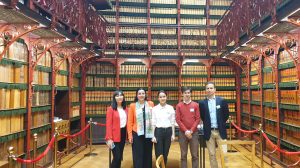EU-US cooperation in Central Asia: parallel lines meet in infinity?

Download “EU-US cooperation in Central Asia: parallel lines meet in infinity?”
EUCAM-Policy-Brief-31.pdf – Downloaded 403 times – 896.19 KBThe European Union (EU) and the United States (U.S.) have many shared interests in Central Asia, but follow different approaches. The main points of convergence are the pursuit of human rights standards, democratic development, stability and security, and the broader economic and social development of the Central Asian states. Naturally, there are also divergences, springing above all from the U.S.’s and the EU’s differing geopolitical positioning throughout the world. While the U.S. focuses largely on hard security, the EU mostly seeks to promote its security objectives through longer-term development approaches. Furthermore, each has its own trade interests in the region, although these do not seem to conflict at large.
The EU and the U.S. are not the principal external actors in Central Asia. Russia still plays a primus inter pares role regarding security, while China has over the last decade taken the lead in the economic and trade sphere in Central Asia. In a context where the two primary external players share borders with the region and where five young states effectively play foreign actors against each other so as to extract maximum profit from external engagement, it would make sense for the EU and the
U.S. to cooperate in areas of mutual interest. This, however, is barely the case.
This paper looks into EU-U.S. shared interests, diverging objectives, and why cooperation is largely confined to irregular coordination talks instead of practical cooperation. It then presents some ideas on areas where joint action would be beneficial.
EU and U.S. approaches
There is practically no coordination or joint EU-U.S. action in Central Asia. The only regular bilateral contact consists of two meetings a year between the U.S. Assistant Secretary for South and Central Asia Affairs and the EU Special Representative for Central Asia. This exchange of information is important, but there is a lack of interaction on lower and higher levels. European External Action Service (EEAS) desk officers have only ad hoc contacts with their American counterparts and, on the ground, EU Delegation officials and US Embassy staff are said largely to go their own way. Higher up the chain, there is no forum to discuss Central Asian challenges similar to the recently-established EU-U.S. dialogue and engagement on Asia-Pacific issues (in which Central Asia is unlikely to be included) or the regular exchanges on the Middle East and North Africa. Central Asia is also unlikely to be a topic of discussion at the EU-U.S. annual summits.
This is not surprising as Central Asia is not a priority for either party, while Afghanistan is slowly moving down the list of priorities for transatlantic actors. Both the EU and the U.S. prefer to channel their cooperation through NATO concerning hard security; the Organisation for Security and Co-operation in Europe (OSCE) regarding soft security; and the United Nations Development Programme (UNDP) on development. But delegating cooperation to multilateral institutions does not seem to be working: NATO does not play an active role in the region (besides the low-impact membership of Central Asian states in the Partnership for Peace – PfP – programme); the OSCE is marginalised in a region where local governments are weary of democratisation initiatives; and UNDP is only one of many development actors.
The EU and the U.S. see Central Asia from very different perspectives. Washington looks at the region through two lenses in particular. First, it regards Central Asia as part of its Asia policy. The State Department has one bureau for South and Central Asia. At the same time, the Defence Department has included Central Asia within CentCom, which covers North Africa, the Middle East, Afghanistan and Pakistan. This shows that Washington has left behind the notion of the former Soviet space and dissociates the area from Russia. Second, most U.S. policies towards Central Asia seem to be directly linked to the war effort in Afghanistan. Central Asia seems to be an appendix of the U.S.’s Afghanistan policy. This became apparent when former State Secretary Hilary Clinton introduced the new Silk Road vision in 2011 – a vaguely defined plan that seeks to foster regional economic cooperation and trade in a broad region in which Afghanistan serves as linchpin. The new Silk Road will be all the more difficult to follow as it is unlikely to include China and Iran (two crucial states in the broader region) and it remains silent on the role of Russia.
For its part, Europe sees Central Asia as an extension of its neighbourhood. The view is still largely ‘Eurasian’, regarding the Central Asian republics as former Soviet states. With the European Neighbourhood Policy (ENP) – which seeks to build strong bonds with North-African, Middle Eastern, Eastern European and South Caucasus countries – firmly in place, the next logical step in terms of the EU’s developing external policy was to devise a Strategy for Central Asia, launched in 2007. The strategy is an extension of Europe’s links with its Eastern neighbours and Russia, while at the same time being a policy in its own right, with separate funding mechanisms and policy structures addressing Central Asia as a distinct region. The EU’s approach to Central Asia is largely separate from Afghanistan, although policy-makers increasingly pay lip service to an obvious link in light of the 2014 ISAF withdrawal from Afghanistan while the matter is debated in official meetings between Europe and Central Asia.
Whereas the EU projects its ‘strategic’ neighbourhood as far as Central Asia and insists on geographical continuity, U.S. policy looks at the region as part of a broader set of geopolitical calculations. The new U.S. policy toward Uzbekistan, and Tashkent’s return as a potential ally after years of cold relations, cannot be explained only by the need to transit U.S. material leaving Afghanistan through Uzbek territory. It also confirms Washington’s classic strategic reading of Central Asia, in which the main demographic and centrally-located power, Uzbekistan, is given a specific status. What is more, for its part Tashkent is expressing a desire to distance itself from Russia-backed Eurasian institutions.
Central Asian security and Afghanistan
Over the past two years, EU and U.S. approaches to Central Asia have increasingly focussed on the drawdown of NATO forces from Afghanistan. Both actors try to push the Central Asian governments to become more responsible stakeholders on broader cooperation around Afghanistan, especially in the ‘Heart of Asia’ process. But their view of Central Asia as Afghanistan’s neighbourhood is mainly oriented toward short-term security issues.
Both the EU and the U.S. need Uzbekistan, and to a lesser extent the other Central Asian regimes, to withdraw large quantities of material from Afghanistan via the Northern Distribution Network (NDN). The two actors have thus been supporting the Central Asian narrative centred on a spillover threat from Afghanistan, which distracts attention from their own security challenges that often stand separate from Afghanistan – inter alia opposition to and uncertainty about the incumbent regimes, poverty and migration, and tensions over natural resources – and serves to ensure continuous Western involvement in Central Asia as a way to dovetail Chinese and Russian influence. EU and U.S. policies are short-sighted, as they benefit more the Central Asian regimes seeking to extract as much revenue as possible during this short ‘window of opportunity’.
The EU recently initiated regular High-Level Security Dialogues with Central Asia, in order to discuss ‘common threats and challenges’. The mechanism should help build cooperation between Europe and Central Asia, as well as among the Central Asian republics themselves. The first meeting was held in Brussels in June 2013, but interest seemed limited as the five Central Asian states either sent deputy foreign ministers or were represented by their Brussels ambassadors. The topics under consideration largely focussed on anti-drug-trafficking strategies and programmes, as well as on Afghanistan. Whereas there is some will in EU quarters to address human security issues, Central Asian states prefer to emphasise external threats and terrorism. Meanwhile, the U.S. discusses security through its Annual Bilateral Consultation process with each of the five Central Asian states. In theory, there is a division of labour between the Defense and State Departments – between hard and soft security – but in practice the latter has to follow the directive line issued by the former. The Defense Department tends to focus only on external threats with Central Asian governments, while the State Department tries to offer a broader definition of security. Both work jointly on projects like the U.S. Central Asia Counter-narcotics Initiative (CACI).
Both the EU and the U.S. are engaged in Security Sector Reform (SSR), although they tend to focus on different topics and use different methods. The EU’s and its member states’ main focus is on border control, police reform and judicial reform. Europe seeks to emphasise long-term reform and although its contribution in terms of materials is limited, it does provide some training and material deliveries such as support to border guards, especially in Tajikistan. The U.S. focuses more on hard security and short-term assistance through training and materials. Clearly the Central Asians prefer concrete deliveries of weaponry and infrastructure to reform schemes that are seen as interference in domestic policy. Washington and Brussels need to liaise more closely to prevent U.S. military support undermining Europe’s ‘soft’ security support, as well as avoiding a situation where Central Asian leaderships can pick and choose which assistance to accept.
EU-U.S. cooperation on security should move beyond the OSCE, among other factors because the organisation’s effectiveness is often affected by a persistent schism between Western (EU and U.S.) and Eastern (Russia and Eurasian states) participating states. There is scope for the EU and the U.S. to cooperate bilaterally in police reform and border management support. Closer cooperation between the EU’s BOMCA programme and the U.S. training of security personnel at the U.S.-German Marshall Center and at the U.S. National Guard State Partnership Programme would be of added value. Practical cooperation on the ground could also involve dividing strips of the border to focus on (as is the case in Tajikistan). But most importantly, the EU and the U.S. could increasingly streamline their programming to gain leverage when applying conditionality with recipient governments. Establishing a joint working group on border control support would be a step in the right direction.
Development aid and a values-based approach
Both the U.S. and the EU hold regular human rights dialogues with Central Asia. The EU Human Rights Dialogues with Central Asian states have become standard practice where regimes easily rebuff criticism and concerns. Meanwhile, the existence of such dialogues means that human rights are treated as a separate issue that receives less attention in other dealings regarding energy, security and education. In the U.S. framework, human rights are dealt with at the Annual Bilateral Consultation as only one element among several others such as scientific and technological collaboration, economic development, and defence. Whereas both actors continue to use values rhetoric, they understand their leverage is limited. Short-term stability and trade and energy interests clearly override a genuine stress on human rights and democratisation. But here also there is scope for cooperation, for instance, by closely coordinating public statements on human rights abuses on behalf of both parties. The two actors could also improve coordination when preparing their annual talks with Central Asian states about human rights.
Development aid through the EU’s EuropeAid and the United States Agency for International Development (USAID) is ill- coordinated and has only a limited impact. There are several reasons for this, ranging from the low priority attached to Central Asia to unwillingness to reform, as well as high levels of corruption and curtailed U.S. and EU development budgets. For USAID, Kyrgyzstan is the main focus while lesser attention is devoted to Tajikistan. The EU is roughly equally active in both countries. But aid effectiveness is severely undermined by corruption, recipients’ low absorption capacity and, in the case of Tajikistan, by a regime that does not show any inclination to reform or improve the rule of law. Whereas the EU Delegations and U.S. Embassies on the ground regularly coordinate with most donors within existing coordination mechanisms, there is little scope for joint action in this area. Budget cycles are different and difficult to streamline on subjects of mutual benefit.
Support to civil society also varies greatly. Whereas it is time- intensive and complicated for NGOs to obtain EU funding, once the EU provides funds it only expects basic reporting and monitoring. U.S. funding for civil society is less bureaucratic and can be provided quicker, although monitoring of implementation is more hands on.
In terms of trade, the EU is a much more influential actor than the U.S. Both seem to focus largely on trade with Kazakhstan. While the EU makes up for almost 50 per cent of Kazakhstan’s trade, the U.S. accounts for only 2.6 per cent. The U.S. prism on Central Asian economies rests essentially on the involvement of a few energy firms in the Kazakh part of the Caspian Basin, and support for the severely-delayed TAPI (Turkmenistan-Afghanistan- Pakistan-India) gas pipeline. Meanwhile, the EU’s plans to have Turkmen gas flowing to Europe through the Southern Corridor seem to have withered almost completely, especially with the cancellation of Nabucco. Despite these differences in interests and strategies, there is not much trade competition between the EU and the U.S. as the region is not a priority for either while the EU’s share by far surpasses that of the U.S.
Conclusion
At the moment there is little scope for increased EU-U.S. overall cooperation beyond the formats already in place. The parallel policy interests barely seem to meet. Bureaucratic traditions and budget cycles are largely divergent. Both U.S. and EU decision- making mechanisms are very complex, with a multitude of actors involved (State, Defense, White House and Congress for the former; the European Commission, Council, Parliaments and member states for the latter). U.S. policy is probably quicker and more adaptable, but also suffers from a very short-term institutional memory. The EU is slower and thinks in longer terms, probably with less zigzagging.
But these differences extend beyond respective bureaucratic structures and cultures. First, Central Asia is not a priority for either actor. Opportunities in and challenges from South and South-East Asia, crises in the Middle East and concerns in Europe over the neighbourhood rank much higher on the agenda. There is no perceived urgency in joining forces in Central Asia. Second, their different geographical view of the region – US’s Asia versus EU’s Eurasia – complicates strategic convergence. Third, much lip service has been paid to Afghanistan post-2014 scenarios but little has been done to adapt existing policies. The EU and the U.S. clearly acknowledge their status as secondary actors in Central Asia after Russia and China. In case of severe crises in the region, Russia will remain the primary actor able and maybe willing to act. Europe is highly unlikely to intervene due to its limited means and interests, and the U.S. would also seek to abstain if possible.
However, the EU and the U.S. should at least prepare for the event that Central Asia becomes a priority. The high level of authoritarianism, instability and prospects for conflict cannot be disregarded and left to the realm of Chinese and Russian regional policies. The EU and the U.S. have two options: closer cooperation and bilateral coordination or revamping the OSCE while strengthening NATO involvement in Central Asia. However, the OSCE is weakened by continuous differences among its participating states, which include the Central Asian countries, making it difficult to turn it into an influential regional actor under EU and U.S. leadership. Increased NATO involvement will be countered by the Central Asian states’ membership of the Russia-driven Collective Security Treaty Organisation (CSTO), while the establishment of a Eurasian Union and the Shanghai Cooperation Organisation (SCO) leave little room for manoeuvre.
In this context and despite the many difficulties, the EU and the U.S. would be well-advised carefully to coordinate their approaches, especially in the fields of security, development and shared values. Allowing Central Asian governments to pick and choose partners enables them to play one actor against the other without engaging in much-needed reforms. EU-U.S. coordination and cooperation on border control support; promotion of democratic and human rights values; and development aid would help to increase leverage over local regimes, as well as increase the effectiveness of their respective or joint assistance programmes in the region.







